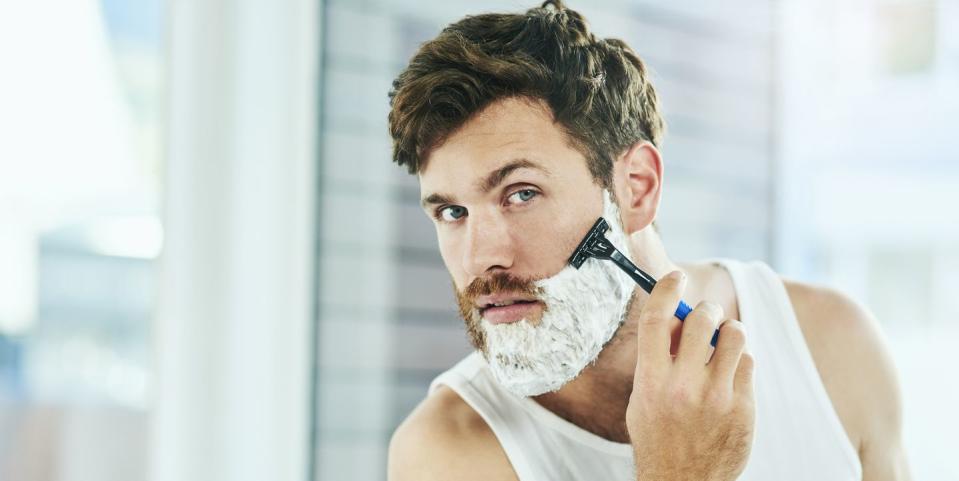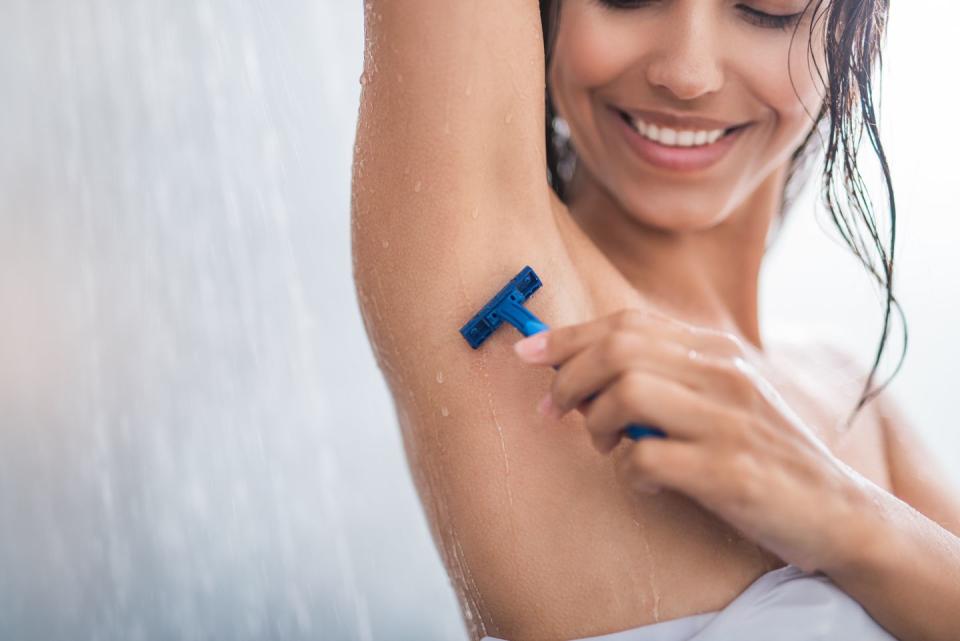10 ingrown hair treatment and prevention tips

If you’re struggling with ingrown hair, you’ll know firsthand just how itchy and irritating it can be. Coupled with the fact it often causes embarrassing bumps on your skin and can even become infected, you’ll want to deal with this pesky problem quickly and effectively.
We spoke to Rachael Burns, Consultant Dermatologist at Sondskin and Abbas Kanani, pharmacist at Chemist Click, for expert advice on how to treat and prevent ingrown hairs for good:
What is an ingrown hair?
Typically, hair follicles produce hairs that grow out of the skin and up towards the surface. Ingrown hairs, which often look like blemishes, are in fact hair that has grown back into the skin, says Burns.
'This usually happens when the hair follicle is blocked, which means hairs are forced to grow back towards the direction of the skin,' adds Kanani.
Ingrown hairs can cause inflammation, pain and tiny bumps that looks like blemishes in the area once the hair has been removed. In the worse case scenario, ingrown hairs can become infected. 'This condition is known as folliculitis,' says Kanani. 'Folliculitis is treated with antibiotics, but if you have a one-off case of an infected ingrown hair, you should leave it alone – the infection should resolve spontaneously.'
What causes ingrown hairs?
One of the most common causes of ingrown hairs is the hair removal process, including shaving, waxing and tweezing. 'These methods remove hair in a way that leaves the hair with a sharp edge, increasing the likelihood of the hairs poking back and growing under the skin,’ says Kanani.
If you struggle with acne and spots you are also more likely to get ingrown hairs. 'This is because the follicles are blocked and do not allow hairs to grow out towards the surface of the skin,' says Kanani. 'People with coarse or curly hair are also more likely to experience ingrown hairs.’

Ingrown hair symptoms
Battling with post-shave rash on your legs, bikini area or beard? Ingrown hairs can easily be mistaken for spots or acne. ‘Ingrown hairs are most common on softer areas of the body where hair has been removed, such as the face, armpits and genital areas,’ says Kanani. According to Burns, common signs and symptoms of ingrown hair(s) include the following:
Pustules - small, pus-filled blister-like lesions
Papules - small, round bumps
Hyperpigmentation - skin darkening
Itching
Pain
Ingrown hairs usually appear as small bumps on the skin, often in clusters. ‘The colour depends on your complexion – they will appear red on lighter skin and black on dark skin,' says Kanani. 'If infected, they can appear as white bumps. The bumps are often painful and tender to touch.’
Ingrown hair treatment tips
Often an ingrown hair improves without treatment, but if you suffer from persistent ingrown hairs or they regularly become infected, the following treatment tips may help:
• Exfoliate regularly
Exfoliate the regions where ingrown hairs are prevalent. This can help to unblock pores, encouraging hairs to return to the surface of the skin. 'If you’re seeing no improvement you should begin by applying exfoliating scrub to the area to help release any trapped hairs,' says Burns. 'If this doesn’t work after a number of applications over a couple of days, then it’s advisable that you have the ingrown hair assessed by your GP.'
• Use sterilised tweezers
If the tip of the ingrown hair is close to the surface of the skin, use a sterilised tweezer to remove them. 'Using a warm compress beforehand will allow hairs to rise to the surface, making this process easier,' says Kanani
• Do not irritate the area
Resist the urge to further exacerbate the area. 'Avoid removing hair for example, by shaving in the area where the ingrown hair is,' says Kanani. 'This can cause irritation and could cause the ingrown hair to become infected.'
• Try retinoid creams
Retinoid creams help to regulate the turnover of dead skin cells, so they can help to unblock pores, allowing hair to grow back towards the surface of the skin. 'These creams need to be prescribed by a medical practitioner, so book an appointment with your GP,' says Kanani.
Infected ingrown hair treatment tips
If your ingrown hair becomes red or sore to touch, it might be infected. Try the following tips to treat infected ingrown hairs:
✔️ Apply a warm salt compress
Self-help techniques, such as gently exfoliating around the region, may help. 'Try applying a warm salt compress to help to clear the infection more quickly,' advises Kanani.
✔️ Differin gel
You can treat infected ingrown hairs with over-the-counter medication. 'Differin gel can help reduce inflammation and decrease the size of the cyst,' says Burns. 'Failing that, it’s advisable you seek an assessment with a GP or dermatologist who can prescribe steroid cream or oral antibiotics to help reduce the redness and pain around the cyst.'
✔️ Antibiotics for infection
If your ingrown hair becomes red or sore to touch, it might be infected and you may require a course of antibiotics. ‘Ingrown hairs can sometimes become infected, and some individuals will experience this on a regular basis,’ says Kanani. ‘You should leave it alone – the infection should resolve spontaneously.'
⚠️ If your ingrown hair infection doesn’t appear to be clearing, or it is getting worse or more painful, visit your GP, who may be able to prescribe antibiotics or an anti-inflammatory cream.
Ingrown hair prevention tips
Once you’ve treated your ingrown hair effectively, follow these steps to prevent ingrown hairs from recurring in the future:
1. Exfoliate twice a week
Exfoliate regularly to help prevent your pores from getting blocked.
2. Preparation is key
Prepare your skin in advance before you remove hair. 'Begin by washing your skin with warm water and apply a facial cleanser before you begin removing hair,' says Burns.
3. Technique is everything
Use the correct shaving technique. 'Wax or shave in the direction that the hair is growing and ensure you rinse your skin and apply an aftercare lotion,' says Burns.
3. Invest in a decent razor
Do not reuse disposable razors, and use a single-blade razor if possible, to reduce the chances of ingrown hair.
4. Only shave slack skin
Do not stretch your skin for a sharper shave as this can lead to ingrown hair.
5. Buy shaving cream or gel
Always use specifically designed products such as a shaving gel or cream, to help lubricate the area and decrease the likelihood of sharp edges. 'Apply a lubricant shaving gel or cream a few minutes before hand to soften the hair,' says Burns.
6. Try laser hair removal
Although it doesn't work on all skin types, look into laser hair removal, to remove the need for shaving altogether.
7. Stop removing your hair!
To avoid ingrown hairs it’s advisable that you stop wet shaving, waxing or tweezing. 'Of course, this is not always possible,' says Burns. 'But there are a number of other hair removal methods that you could explore.'
8. Use electric razors
How you remove hair can make a real difference, so invest in an electric razor. 'Avoid using the electric razor on the closet setting and hold it away from your skin when shaving,' says Burns.
9. Try hair growth prevention cream
Hair growth prevention cream reduces growth from the follicles, providing a long-lasting solution to unwanted hair without the need for shaving or waxing. 'Vaniqa is a prescription hair growth prevention cream that decreases hair regrowth when combined with laser therapy,' says Burns. Vaniqa is only available on prescription so ask your GP for advice.
10. Use chemical hair removal
To remove the need for shaving altogether, some people prefer chemical hair removal. Try Woowoo vegan intimate hair removal cream.
Last updated: 30-03-2021
You Might Also Like

 Yahoo Finance
Yahoo Finance 